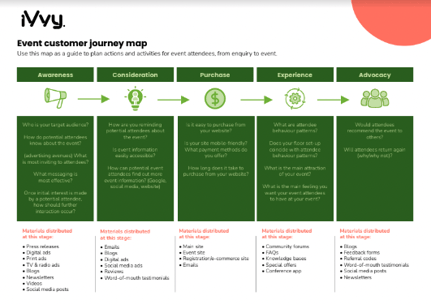If you’re an event manager, you know that the customer experience is one of the most important factors in creating a successful event. Understanding how your customers interact with your brand before, during, and after an event can be difficult—unless you take the time to construct a customer journey map. In this blog post, we’ll go over what customer journey mapping is and why it’s essential for event managers to understand.
What Is Customer Journey Mapping?
Customer journey mapping is simply a visual representation of all the steps a customer takes when interacting with your company. It includes everything from their initial awareness of your brand to their post-event experience. This includes their pre-event interactions (e.g., researching venues or ticket options), their experience at the actual event (e.g., ticket scanning, food/beverage purchases, etc.), and any follow-up activities they may do after the event (e.g., providing feedback).
The Benefits of Customer Journey Mapping
Understanding customer journeys has multiple benefits for event managers. For starters, it allows them to pinpoint areas where they can improve their customers’ experiences—such as streamlining check-in processes or providing more informational signage throughout the venue. Additionally, understanding how customers move through each stage of their journey can help event managers identify opportunities for upselling products or services during particular points in their journey—which could result in increased revenue for the organization. Finally, by monitoring customers’ post-event behaviour (such as reviews or social media engagement), event managers can gain valuable insights into what worked well and what didn’t—allowing them to adjust for future events accordingly.
Different Parts of the Event Customer Journey
The first step of customer journey mapping is to understand each part of the customer’s journey. There are several different components that should be taken into consideration when creating your map: awareness, consideration, purchase/registration, attendance/participation and post-event review. Each component will be unique depending on what type of event you are organizing and who your target audience is. For example, if you are organising a virtual conference for professionals in the tech industry, your awareness phase might include targeted ads on LinkedIn and Twitter while your consideration phase might involve sending out promotional emails with detailed information about the conference agenda and speakers.
On top of this, you should also consider how customers move between these different phases of their journey—what prompts them to go from one step to another? Understanding this helps you identify potential problems they may face during their interaction with your event and work on solutions so they don’t have a bad experience.
Customer journey mapping is an essential activity for any event manager who wants their attendees to have a positive experience from start to finish. By understanding each phase of the customer’s journey and how they move between each phase, you can ensure that any obstacles or frustrations that arise during their interaction with your event can be addressed quickly and efficiently. Mapping out your customers' journeys will help ensure that everyone has an enjoyable time at your next event!
Your free event customer journey map template
Take a closer look at each stage of the event management process, and keep attendees engaged from enquiry to event day.

.png)
.png)